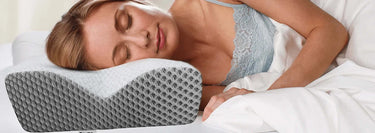Why Consistent, Structured Leg Elevation Supports Daily Posture Alignment

Long days on your feet. Hours at a desk. Travel. Training. Even a normal workday can leave your legs, hips and lower back feeling tight, compressed and out of balance. Structured leg elevation is one of the simplest ways to help your body reset at the end of the day. When you elevate your legs on a stable wedge instead of a stack of soft pillows, your lower body finally gets a chance to relax, realign, and release built-up tension.
This guide explains the real-world benefits of leg elevation for daily reset, why a leg elevation wedge works differently from ordinary pillows, and how to build a short nightly routine that supports long-term comfort. It is written for people who want calm, practical guidance. No hype. No medical claims. Just clear explanations and ergonomic logic.
What Is Structured Leg Elevation?
Leg elevation is simple in theory. You lie back and raise your legs so your feet and calves rest higher than your hips. The goal is to let gravity assist your body rather than fight it all day.
In practice, the way you elevate your legs makes a huge difference. A structured leg elevation wedge uses a defined angle and height to support your calves and thighs from hip to heel. Instead of your legs rolling in different directions on loose pillows, they rest on a wide, stable surface that keeps both sides of your body balanced.
A well designed wedge:
- Supports your legs from mid-thigh to heels with no sharp drop-offs.
- Uses a smooth curve behind the knees so there is no pinching or hard edge.
- Holds its shape night after night rather than compressing into a flat pad.
- Matches your height so your legs feel naturally elevated rather than forced.
You can learn more about the geometry behind this in Innovating Leg Elevation and the Zen Bloks ergonomic design overview. For now, the key idea is simple. Elevation is not only about getting your feet “up.” It is about creating a calm, neutral position that your body can relax into for 15 to 30 minutes without strain.
Why Daily Reset Matters For Your Legs And Back

Modern life asks a lot from your lower body. Some days you stand on hard floors for hours. On other days, you barely move from a chair. Both patterns load the same areas of your body over and over again. Hips, knees, calves, and lower back absorb that pressure and respond with tightness, stiffness, and fatigue.
Without a reset, this tension tends to stack. You go to bed with heavy legs. You wake up with similar tightness. Over time, it becomes your “normal.” Leg elevation works like a daily counterweight. For a short window each day, you reverse that load and give your legs a chance to decompress.

Daily reset with a leg wedge supports:
- Pressure relief for feet and calves. Elevation shifts weight away from your heels and ankles, allowing those areas to relax.
- Gentle hip and lower back decompression. When your legs are fully supported, your pelvis can rest in a more neutral position. That often eases everyday back tension from sitting or long drives.
- Circulation comfort. Elevation encourages a smoother fluid return from your lower legs toward your core, which many people feel as lighter, less “heavy” legs.
- Mental reset. A defined elevation session becomes a short ritual where you switch off screens, slow your breathing, and let your body settle.
Think of it the way athletes treat cool-down time after training. Not optional. Not a luxury. A simple practice that keeps minor issues from building into bigger ones. You do not need to be an athlete to deserve that same level of care.
![]()
Key Benefits Of A Daily Leg Elevation Routine
Every person feels leg elevation a little differently. Some notice instant lightness in their feet. Others feel their lower back finally release after a long day. Below are the most common benefits people report when they use a foam leg wedge consistently.
1. Easing Lower Body Fatigue And Heavy Legs
After hours of standing or walking, your legs can feel dense and heavy. You might notice marks from socks, a sense of fullness in your calves or feet that feels “swollen” inside your shoes. A short elevation session helps your body move that pooled fluid back toward your core.
When your calves rest on a broad surface, and your feet are slightly above your heart line, gravity quietly assists that return. The result many people notice is a subtle lightness and less end of day heaviness in the lower legs. It is not magic. It is simple physics plus patience.
2. Helping Everyday Back And Hip Tension Settle
Sitting compresses your spine from top to bottom. If you lean forward over a keyboard, drive long distances or sink into a soft sofa, your lower back ends up carrying a lot of that load. Tight hip flexors and rigid hamstrings pull on the pelvis, which can leave your back feeling tight by the evening.
When you place your legs on a stable leg wedge pillow, your pelvis gently tilts into a more neutral position. Your lower back lengthens along the floor or mattress instead of being pulled into a curve. This change in geometry often takes pressure off the small muscles that have been working all day to keep you upright.
Many people describe this as “my back finally letting go” or “my hips unkinking.” It is not a treatment. It is your body taking advantage of a position that does not ask those muscles to hold you up for a while.
3. Supporting Better Posture Habits Over Time
Posture is not something you fix in one session. It is the sum of thousands of small positions your body takes each day. Leg elevation gives your nervous system a different reference point. Instead of only knowing sitting and standing postures, your body also experiences what truly supported, neutral alignment feels like from hip to heel.
When you consistently create this neutral position:
- Your core learns how it feels when the lower back is not bracing.
- Your hip flexors get a break from staying shortened all day.
- Your hamstrings lengthen gently without strain.
Over time, this can make it easier to notice when your daytime posture drifts too far into slouching or standing with locked knees. You have a baseline of “this is what aligned feels like” that your body can reference.
4. Supporting Daily Recovery From Training Or Long Workdays
If you walk, run, lift, cycle or perform any repetitive lower body training, your legs are already familiar with micro strain. The goal is not to avoid that entirely. It is to support your body so it bounces back between sessions.
A short elevation window after training or in the evening:
- Gives your feet and ankles a break from constant loading.
- Helps calves and quads release some of the day’s tightness.
- Pairs well with light stretching or breathing drills.
The same logic applies if your “training” is a 10-hour shift or a long travel day. You do not need to be in a gym for your legs to appreciate structured rest.
5. Creating A Calm Pre Sleep Ritual
One of the most underrated benefits of leg elevation is how naturally it fits into a pre-sleep routine. When you elevate your legs for 15 to 20 minutes before bed, you automatically step away from phones, messages and bright screens. You lie back, slow your breathing, and let gravity handle some of the work.
Pairing your wedge with dim light, quiet music or a guided breathing app can signal your nervous system that the day is winding down. That alone can make it easier to transition into sleep with less restlessness and fewer “wired but tired” nights.
6. Helping Your Body Reset After Travel
Airplanes, trains, and long drives keep your hips and knees locked for hours. You sit in a compressed position where fluid has more opportunity to pool in the lower legs. Many people step off a flight feeling puffy, stiff and drained.
Having a dedicated leg elevation wedge at home turns the first evening back into a reset session rather than a collapse on the sofa. Fifteen to thirty minutes of structured elevation can help you feel more like yourself again after the immobility of travel.
How Long And How Often Should You Elevate?
There is no single “right” number that fits everybody. The goal is consistency rather than a perfect timer. Most people find benefit with a window between 15 and 30 minutes per session, once or twice per day.
A simple starting point:
- Evening session. 15 to 20 minutes before bed as part of your wind-down routine.
- Optional afternoon reset. 10 to 15 minutes after work, training or a long drive.
If your legs feel restless or uncomfortable at first, start with shorter sessions and gradually increase as your body gets used to the new position. The dedicated guide How Long Should You Elevate Your Legs goes deeper into timing suggestions, but the central idea is simple. Elevation should feel like a break, not a chore.
Why A Leg Wedge Works Better Than Stacked Pillows
Many people try leg elevation with whatever is closest. Couch cushions, bed pillows, folded blankets. These work for a few minutes then start to collapse or shift. One leg slides off. Your knees end up bent at a sharp angle. Your feet tilt sideways. The position that was supposed to feel relaxing ends up causing more fidgeting.
A purpose-built leg wedge pillow is different because it is designed for stability first. It gives your body a defined structure to relax into:
- Consistent height. Your legs are raised the same amount every time. That makes it easier for your body to adapt and expect the routine.
- Wide surface. Both legs rest on one platform, so your hips stay even instead of twisted.
- Supportive foam. High-density material prevents sinking and keeps your joints in a neutral line.
- Shaped knee cradle. A gentle curve behind the knees avoids sharp pressure or pinching.
Pillows are great for comfort around your head and shoulders. They are not designed to support the weight of your entire lower body. A wedge is. The comparison guide Leg Wedge vs Knee Pillow vs Regular Pillows breaks it down visually if you want a more detailed chart.
Choosing The Right Leg Elevation Wedge For Your Body
To get the most from leg elevation, your wedge should match both your height and how you plan to use it. A wedge that is too low will not feel as supportive. One that is too high can feel forced or uncomfortable at the hips.
Zen Bloks focuses on two main heights: the 10-inch Leg Elevation Wedge and the 11-inch Leg Elevation Wedge. While every body is unique, a simple guideline looks like this:
- 10-inch wedge. Often ideal for people roughly 5'7" to 5'11" or anyone who prefers a moderate incline for reading, relaxing or nightly reset.
- 11-inch wedge. Often preferred by people around 6'0" to 6'5" or anyone who enjoys a deeper angle and more leg clearance.
The height guide in Leg Elevation Height by Body Size explains the logic in more detail, including how body proportions and mattress firmness can affect your choice.
Whichever height you choose, the goal is the same. Your legs should feel supported, not strained. When you place your calves on the wedge and lie back, your body should quietly think, “I can stay here for 20 minutes without fighting this position.”
A Simple Nightly Leg Elevation Routine
You do not need an elaborate protocol to benefit from leg elevation. In fact, the more complicated a routine is, the less likely you are to keep it. Start with something that fits your actual life and build from there.
Step 1: Set Up Your Space
- Place your leg elevation wedge pillow on the bed or a firm sofa.
- Dim the lights or use a warm lamp rather than overhead lighting.
- Silence alerts on your phone or leave it in another room if possible.
- Have a light blanket nearby if you tend to feel chilly while relaxing.
Step 2: Get Into Position
- Lie on your back with your hips close enough to the wedge that your thighs rest fully on the slope.
- Let your calves and heels rest on the upper part of the wedge so your knees are slightly bent but relaxed.
- Adjust until both legs feel evenly supported with no pressure points.
Step 3: Breathe And Release
- Close your eyes and take slower, deeper breaths than you use during the day.
- On each exhale, imagine your calves, thighs and lower back getting a little heavier into the surface.
- Keep your jaw unclenched and your shoulders relaxed. You are not trying to do anything. You are letting gravity work for you.
Step 4: Stay For 15 To 20 Minutes
You can set a gentle timer, listen to calm audio or remain in quiet. When the time is up, roll to your side, lower your legs from the wedge and slowly sit up.
If you pair this routine with reading a few pages of a book, journaling or a short mindfulness practice, it becomes more than leg elevation. It becomes your nightly signal that the day is complete.
Pairing Leg Elevation With Better Daily Habits
Leg elevation does a lot of heavy lifting during your reset window, but your daytime habits still matter. You will feel the benefits more clearly if you combine your wedge routine with small posture and movement upgrades.
- Break up long sitting sessions. Stand, stretch or walk a few minutes each hour to keep your lower body from stiffening.
- Alternate between sitting and standing where possible. A basic sit stand pattern reduces repeated pressure on the same points.
- Pay attention to your footwear. Supportive shoes during the day improve how your legs feel at night.
- Stay hydrated. Your body moves fluid more comfortably when you are not dehydrated.
You do not need a perfect lifestyle to benefit from elevation. Every small improvement in movement and posture multiplies what your nightly wedge session can do.
Comfort And Safety Considerations
Leg elevation is a gentle lifestyle practice for most people, but it is still important to listen to your body. Stop and adjust your position if you feel numbness, tingling or sharp discomfort anywhere in your legs, hips or back.
If you have specific concerns about circulation, joint health or other conditions, speak with a qualified health professional before adding leg elevation to your routine. Zen Bloks® products are ergonomic comfort tools, not medical devices, and they are not intended to diagnose, treat or cure any condition.
How Zen Bloks® Approaches Leg Elevation Design
Zen Bloks started with a simple question. Why are so many leg wedges either flimsy, too narrow or shaped in a way that looks good in photos but does not feel natural for real bodies on real beds and sofas.
After years of testing with different heights, angles and foam densities, the current leg elevation wedge geometry was selected because it consistently helped people feel stable and relaxed without “fighting” the product. The focus is always on three things:
- Balanced alignment. Both legs rest at the same height on a wide platform that keeps hips centered.
- Structured support. High density foam maintains its shape so you get the same experience on day 300 that you did on day 3.
- Calm materials. The cover fabric feels soft to the skin while still allowing enough friction that your legs do not slide around.
If you want the story behind the design choices, the article Innovating Leg Elevation walks through the development process in more detail.
Next Steps In Your Leg Elevation Journey
If leg elevation is new to you, start simple. Choose a wedge height that matches your body, commit to a short nightly routine for two weeks and pay attention to how your legs and lower back feel at the end of the day. Most people realize quickly whether their body appreciates this kind of support.
To go deeper from here:
- Explore the full Leg Elevation Wedges collection and compare height options.
- Read How to Use a Leg Wedge Pillow for step by step positioning tips.
- Visit When to Use a Leg Wedge Pillow to see how elevation fits into different daily schedules.
- Watch setup examples in the Product Videos & Tutorials library.
Leg elevation is a small habit with outsized impact. It takes only a few minutes to set up, yet it gives your body a rare chance to relax, realign and release the strain of the day. When you make that reset part of your routine, your evenings stop feeling like a collapse and start feeling like a deliberate transition into rest.
Zen Bloks® leg wedges are designed for everyday comfort, alignment and relaxation. They are lifestyle products and are not intended as medical devices.





